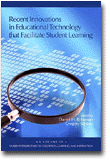
Recent Innovations in Educational Technology that Facilitate Student Learning
Edited by:
Daniel H. Robinson, University of Texas at Arlington
Gregory Schraw, University of Nevada - Las Vegas
A volume in the series: Current Perspectives on Cognition, Learning and Instruction. Editor(s): Daniel H. Robinson, University of Texas at Arlington. Marlynn M. Griffin, Georgia Southern University.
Published 2008
The field of educational technology is exploding in terms of innovations being developed daily. Most of these innovations hold fascinating promise but enjoy almost no empirical support. There are educational researchers who have both developed innovations and tested their potential empirically. This book will capture the latest and most promising innovations from the leading educational technologists in the world, including animations, simulations, visualizations, navigation, manipulatives, pedagogical agents, and assessment. This book is appropriate for university courses in educational technology for those wishing to showcase the latest innovations that are accompanied by empirical support.
CONTENTS
Introduction, Daniel H. Robinson and Gregory Schraw
Assessment of cognitive load in multimedia learning: Theory, methods and applications, Fred Paas, Paul Ayres, and Mariya Pachman
How do animations influence learning? Shaaron Ainsworth
Fostering multimedia learning of mathematics: Comparing the efficacy of animated pedagogical agents to conventional visual cues, Robert K.
Atkinson, Mary Margaret Lusk, and Alan Koenig
AutoTutor: Learning through natural language dialogue that adapts to the cognitive and affective states
of the learner, Arthur Graesser, Vasile Rus, Sidney, D’Mello, and G. Tanner Jackson
The role of self-regulated learning in learning about science with hypermedia, Roger Azevedo
Design rationale within TELS projects to support knowledge integration, Douglas B. Clark, Keisha
Varma, Kevin McElhaney, and Jennifer Chiu
Rapid computer-based diagnostic tests of learners' knowledge, Slava Kalyuga
Beyond clicks and semantics: Facilitating navigation via the web’s social capital, Kim Lawless and P.G.
Schrader
Physically distributed learning with virtual manipulatives for elementary mathematics, Taylor Martin
A computer-based, team-based testing system, Daniel Robinson, Michael Sweet, and Michael Mayrath
-
Paperback978-1-59311-652-1
Web price: $45.04 (Reg. 52.99)
-
Hardcover978-1-59311-653-8
Web price: $80.74 (Reg. 94.99)
- eBook9781607529422

- EDU001000 - EDUCATION: ADMINISTRATION: General
- EDU037000 - EDUCATION: Research
- EDU015000 - EDUCATION: Higher
-
 Assessment of Higher Order Thinking Skills
Assessment of Higher Order Thinking Skills
-
 Learning Through Visual Displays
Learning Through Visual Displays
-
 Misinformation and Fake News in Education
Misinformation and Fake News in Education
-
 Social Media
Influences on Education
Social Media
Influences on Education
-
 Teachers’ Personal Epistemologies
Evolving Models for Informing Practice
Teachers’ Personal Epistemologies
Evolving Models for Informing Practice
-
 Technology-Based Assessments for 21st Century Skills
Theoretical and Practical Implications from Modern Research
Technology-Based Assessments for 21st Century Skills
Theoretical and Practical Implications from Modern Research
-
 Use of Visual Displays in Research and Testing
Coding, Interpreting, and Reporting Data
Use of Visual Displays in Research and Testing
Coding, Interpreting, and Reporting Data

